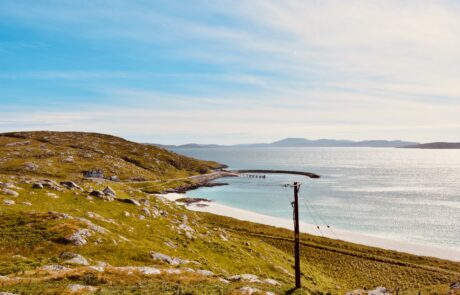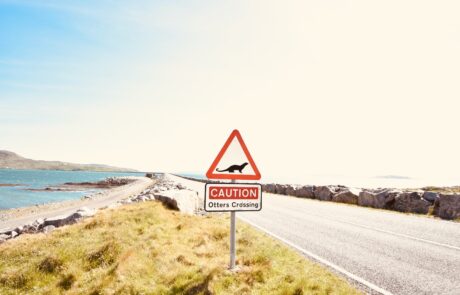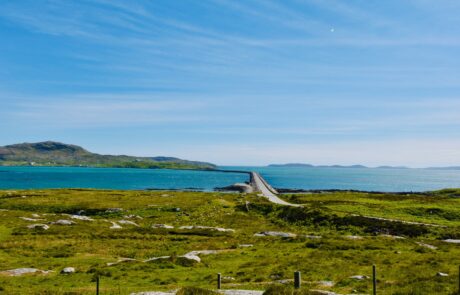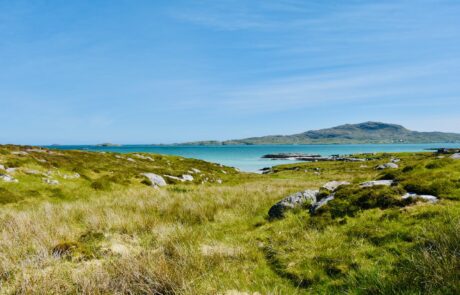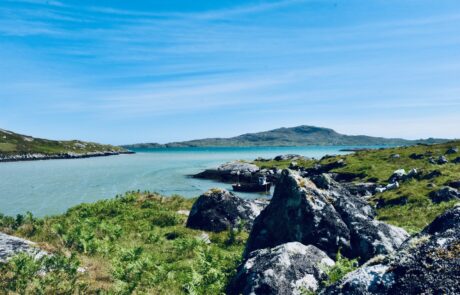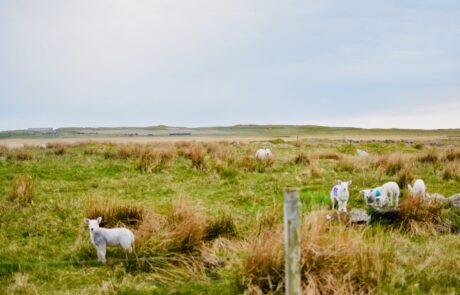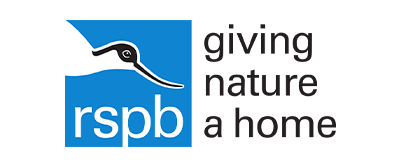Islands of North Uist, Baleshare, Berneray and Grimsay.
Eileanan Uibhist a Tuath, Baile Sear, Beàrneraigh, agus Griomasaigh.
For many of our guests, Balranald, with its soothing calm and natural beauty, offers all they want from their time away from the hurly-burly of modern life. But equally, for many the cottage provides a centre for exploring further, the circumference being the scenic circular road and its many fascinating branches.
Whether you’ve come to take your ease or take to the roads, it’s likely you’ll need to buy some food, perhaps a newspaper, or send a postcard or two. You’ll find all these at Bayhead (Ceann a Bhaigh), about two to three miles away to the south east along the A865 circular road. If you’ve a mind to drive further then you can get petrol here too.
South of Bayhead are the heartland of North Uist – the crofts and townships of the Cladach – the word means shore, and that’s what there’s plenty of hereabouts, as centuries of storms and erosion have eaten the machair into myriad channels and straits, rocky islets and sandy islands proper.
Before Clachan na Luib you’ll find the Hebridean Smokehouse, where they make the finest cold- and hot-smoked salmon and trout. From a viewing area you can watch the filleting and smoking in progress, and in the shop you can ‘try before you can buy’ The shop is well stocked with other lovely things, too!
At Cairinis, about two miles south of the Baleshare T-junction, you’ll find the remains of Teampull na Trionaid (The Church of the Trinity), an important centre of religious learning in medieval times. The stonework’s were saved from utter ruin by extensive works carried out in 2011.
South from Cairinis the A865 continues across the North Ford Causeway, connecting North Uist with Benbecula, via a series of smaller islands, mostly too small to be inhabited, some by just one crofting family, and the Isle of Grimsay (Griomasaigh) by a thriving community.
Just east of Clachan the long road along the south shore of Loch Euphort is a delight, with wonderful scenery, a tiny art studio, and a landscape rich in iron age archaeology. Back at Langass by the main road there’s a very impressive chambered cairn up on and hillside – Barpa Langais, and a very impressive stone circle – Pobull Fhinn, or Finn’s People – along the track just past the Langass Lodge Hotel (which is highly recommended for meals).
Lochmaddy (Loch nam Madadh) stands at the head of an extensive, sheltered natural harbour which has for centuries served as the principal port for North Uist, and today is the busiest ferry port in Uist and Barra. Though boasting a Sherrif’s court, two hotels, school, an outdoor activities centre, cattle market, tourist information office, and the renowned Taigh Cearsabhagh arts center, Lochmaddy is still little more than a quiet village – except perhaps when the Calmac ferry from Uig in Skye comes in!
North from Lochmaddy, a narrow road branches east to Loch Portain and Cheesebay (Bàgh a Chàise), weaving bewilderingly through a landscape of convoluted bays and inlets of the sea, fresh water lochs, rocky promontories and few distinctive landmarks: it is surprisingly easy to feel disorientated. A truly remarkable district and rich in ancient archaeology, including the impressive galleried Dun Torquil, a scheduled ancient monument, reached by a stepping stones from the shore of Loch an Duin.
Historically, the island of Berneray (Beàrnaraigh) was considered part of distant Harris, but since the causeway was completed in the late 1990’s, the island has become an integral part of Uist life, with many of its residents working as far away as Balivanich or even South Uist. With an enterprising culture, a strong sense of community, a lively programme of events, this is now a growing community with a bright future. Unusually, it is the east coast of that is most densely settled (it’s where you’ll find the Ardmaree Stores and Lobster Pot Café): the west coast is a wide open plain of glorious machair grassland with abundant wild flowers and orchids, and with a ribbon of dunes and white shell sand giving way to a turquoise sea.
The ferry connecting Uist directly to Harris at Leverburgh uses a slipway at the north end of the Berneray causeway, but for those not hurrying to catch a ferry, the narrow and twisty west coast road offers a slow and leisurely tour of the west coasts of North Uist, and its many many attractions. Even before you get back to the circular A865, at Newtonferry (Port nan Long) there’s the extraordinary remains of Dùn an Sticir, accessed by stepping stones from the south shore of Loch an Sticir: this is one of the best of its kind, anywhere.
Further Afield in Uist
The islands that are collectively known as Uist – from Berneray in the north to Eriskay in the southoffer a variety of landscape, sense of place, people, history and culture. One thing they all have in common is good clean fresh air, an abundance of wildlife, and plenty of space to think and be yourself.
Grimsay
Griomasaigh
The whole point of a holiday in Uist is – surely! – to relax; but to help you prepare for the mental gymnastics on your return to mainland life, Uist has set up a few puzzles to keep you alert. Like two islands with the same name, just a few miles apart. This Grimsay is the one you can’t avoid if you’re exploring further afield, as the main north-south road crosses the western tip of the island. It’s is a small friendly island offering a surprising variety of landscape and outlook. A narrow winding road circles the island. with crofts running from the rocky shores up towards the low hills and many lochs at the interior.
The main settlement, at the east end of the island, is Kallin. There you’ll find a fishing harbour, boats and seafood businesses, and a lively cultural centre at the old school. Also at Kallin is the Grimsay Boatshed where historic boats are restored and new boats built and which is the heart of the annual Grimsay Boat Day held each May – a lively and popular day for islanders and visitors alike.
From the number of known archaeological sites dated to that period, Grimsay was probably well populated in the Iron Age. There is a particularly fine example of a wheel-house, the typical house type of those times, close to the north coast of the island: although some distance from the circular road, it is readily found and is well worth visiting – but please take care not to damage the fragile remains.
Benbecula and Isle Grimsay
Beinn na Faoghla agus Eilean Griomasaigh
Benbecula (Beinn na Faoghla) lies to the south of (the first) Grimsay, at the far end of the long and twisting North Ford Causeway. The island is about five miles east to west and is divided roughly in half by three miles or so of the main north-south road.
Balivanich (Baile a’ Mhanaich) is a scattered settlement that’s gradually acquiring the population and the services of a small town; from humble (and not very pretty!) beginnings as a military outpost during the Cold War, it has developed already into the principal center serving Uist and Barra – second only to the capital of the Outer Hebrides, Stornoway. The airport, with its daily Flybe/Logainair flights to Stornoway, Barra and Glasgow.
East of the main road is Beinn Ruabhal, with a track leading out into what may now seem a wilderness, but which briefly between the 1st and 2nd World Wars was the crofting township of Rosinis, the remains of which can be reached by following a waymarked path. In the south east of Benbecula, a long, narrow and very winding road leads eventually to Peter’s Port (Port Pheadair) – a tiny fishing harbour used by small boats. After Hacklet, a very long branch road heads off into the wild eastern extremity of Benbecula, ending at the tiny and very remote crofting settlement of Uisgebhagh. Back on the road to Peter’s Port, the road twists and turns amongst the rock and water, joining up many small islands. one of these being the other Grimsay, known locally as Isle Grimsay (Eilean Griomasaigh), to distinguish it from the Isle of Grimsay (Griomasaigh).
South Uist and Eriskay
Uibhist a Deas agus Eilean Eirisgeidh
South Uist has a distinct grain running along the length of the island, with the Atlantic shore on the west, a belt of dune and marram grass and behind that the fertile machair plains where the oldest crofting settlements are to be found, now connected by branch and loop roads. The main north-south road – which dates from the 1840s – takes a direct route through the land of rock peat and lochans known as talabh dubh (black earth): historically, this landscape did not attract settlers and even to this day there are few houses along the main road, except where it comes close to the older settlements, as at Howmore.
East of the main road the hills run a chain hills rising around 2000ft in height, including the striking peaks of Thacla (Hecla) and Beinn Corradale, and of above all the long ridge of Beinn Mhor. Among and beyond these hills are many secluded glens, secret caves, red deer and eagles, numerous remains of pre-historic peoples, and the cave where Bonnie Prince Charlie sheltered after Culloden before his escape back to France.
A good place to set out into the wilds of the east coast is from Loch Skipport (which in the 19th century was the main port for South Uist, but is now derelict), or better still from North Loch Aineort. Leaving space for vehicles to turn, park at the far end, and set out along the path through the woods, past the abandoned villages of thatched houses before striking up into the hills. With fair conditions it’ll be a day to remember!
The only substantial settlement on the east side of South Uist is Lochboisdale (Loch Baghasdal) which since the late 19thC has been the main port for the island, with Calmac ferries to Oban (and at one time to Mallaig). Lochboisdale is no more than a village, but nonetheless has a large and busy hotel, bank, post office with internet café, fuel station (with car wash) and garage services, a small fishing harbour, tourist information office, church a butcher and other small shops. Like Lochmaddy, the village is transformed into a very lively scene when the ferry comes in! Plans are afoot to transform Lochboisdale with a new port capable of taking cruise ships, a marina, industrial and commercial development, and housing.
The west side of Uist is renown for its white sand beaches and dunes stretching for miles and miles (there are rocky and pebbly lengths, but they’ve got their own attractions!). The dunes – stabilized with marram grass – are the first line of defense for most of the fertile but low-lying machair grasslands, which today are grazed by cattle renown for their quality and natural health. But at Askernish (Aisgernis) a rare exception to this industry is an 18-hole golf course, recently discovered to have been laid out by ‘Old Tom’ Morris in 1891, and now restored to form one of the most rewarding links courses in Scotland.
Stretched out along the machair and talabh dubh of South Uist lie the many crofting townships – scattered crofts organized into communities that as well as their individual fields share hill grazing. It’s well worthwhile turning off the main road and exploring the quiet lanes that connect these quiet places. Howmore (Taobha Mòr) is one of the most picturesque of these, with its thatched houses (and thatched youth hostel too), medieval ruins, historic white church (a rare example of a communion table where it should by rights be – in the middle!) and one of the largest flocks of the black Hebridean sheep in Uist. There’s a filling station and garage services, and Rohan cycle hire and repair, with Beinn Mòr as a dramatic backdrop.
At the north east of South Uist, Iochdar and its neighboring villages make up one of the most anciently settled parts of Uist. There’s a strong sense sense of community in these parts, not only ensuring the survival of their schools, churches, and village hall, but in recent years adding sports fields partly funded by income from wind turbines.
The sands, dunes and islands – particularly the long finger of Gulan ring with the sound of birds at any time of year, and are well worth pulling on extra clothing for as protection against the wind and any passing showers. In less clement weather, you may prefer to just watch the wildlife from Hebridean Jewellery, where as well as treating yourself to something beautiful, you can buy books and other gifts, and sit down for a welcome coffee and cake and enjoy the view.
Another anciently settled area stretches from Askernish (Aisgernis) through Daliburgh (Dalabrog), Kilphedar (Cille Phedair), Leth Meanach, Garrymonie and Smerclete and West Kilbride (Cille Bhrìghde). If you’re on foot, bike or with a horse, you can either follow the lanes or the old machair tracks which provide a quiet and very beautiful route among the machair flowers and crops, the marram grass and the white sand beaches. Why not take a break at the 18thC Polochar Inn. You might well want to come back for a proper meal!
The southern shore of Uist, from Smercleit and Polochar at the west to Ludag and South Glendale (Gleann Dail bho Deas) is arguably the most beautiful part of South Uist, with glorious seascapes across the Sound Eriskay and beyond to Barra, and in good clear weather sight of Skye, Rhum other islands of the Inner Hebrides and far distant mainland hills. Here you’ve every chance of seeing otters, seals, gannets diving in the channels, eagles and hawks, owls hunting by day. As often as not you’ll find cattle grazing the verges and down on the shore. At West Kilbride (Cille Bhrìghde) you’ll see the Big Garden – the 18thC walled garden of MacDonald I of Boisdale (it was he who told Bonnie Prince Charlie to go home to France), now the only historic, high-walled kitchen garden left intact in the Outer Hebrides, and now again in use for its original purpose – to feed the family that lives there. Seasonal fresh vegetables, herbs and soft fruit are often for sale. Preserves made here and eggs and Hebridean hogget lamb from the family’s croft in Eriskay are also available year-round. In the garden is the Hebridean Wool shed – a treasure trove of hand-spun natural-dyed wools and garments woven, knitted or felted with these.
A mile-and-a-half of causeway, completed in 2002, leads from Ludag to the nearby Eriskay. Like Berneray, the island has a very strong sense of community – centered on its Catholic church, primary school and community-owned village shop. Also as in Berneray, the causeway has resulted in a reversal of decline, with many houses renovated or newly built, younger families, and an onward ferry connection, in this case to Barra. Fishing continues as in years gone by, but with a much smaller fleet in numbers and vessel size, and mostly local shellfish catches: the ancient harbour at Haun (readily recognizable as the Viking word for harbour) is now scarcely used, the much larger and more sheltered natural harbour at Acarsaid Mhòr (predictably on the east coast of the island) having recently been improved. Visitors to Eriskay – as also to South Uist and indeed to Barra, will be struck by the presence of roadside shrines: these reflect the fact that Protestantism never really took root here, despite centuries of official repression of both Catholicsism and the Gaelic language), and these islands are now the only predominantly Catholic areas of Great Britain.
is well worth exploring on bicycle or better still on foot. Lovely beaches and grassy paths stretch along the west coast from Baile (the village) south to Coilleag na Phrionnsa (Prince’s Strand – where Bonnie Prince Charlie first stepped ashore in Scotland in 1745), but there’s breathtaking views to be had from the modest but strategic summit of Ben Scrien (Beinn Sciathan). The east coast is so little visited that is is not uncommon to surprise a golden eagle basking with its wings outspread on a rock – almost stumbling across it. Off the south end of the island, on Stack Island, is the ruined castle of medieval pirates, who used to harass the local population and above all any visitors straying into the area who might be worth a ransom.
Just north of the ferry terminal at Ceann a’ Gearraidh, high above Prince’s Beach, is a lay by commanding fine views over the Sound of Barra. It is a wonderful place to stop and take breath (not least if you’ve just cycled up the brae from the ferry!). If you find yourself dreaming of making the crossing to Barra, then that’s natural enough. But that’s another and very different holiday, for if you haven’t realized it already, there’s really more than to do and explore in Uist than can possibly fit into a week – or even a fortnight’s – holiday. You really need to come back again!

